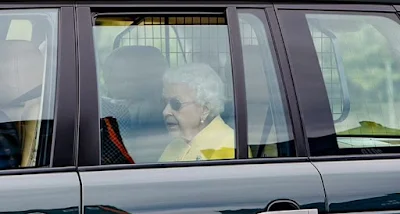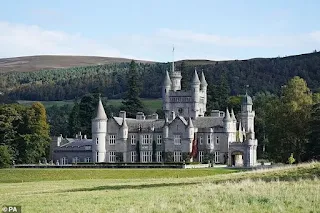Queen Elizabeth II died in Balmoral estate, and according to the royal correspondent, Katie Nicholl, perhaps the Queen already knew that she was not going to come back to Windsor Castle. And she chose to spend the last remaining days of her life there.
Balmoral estate was where the Queen spent countless summers her entire life, and where she had many happy memories with her beloved Philip. The Queen's love affair with Balmoral, indeed, spanned her lifetime.
The Queen's peaceful oasis
As the sight of the car carrying the Queen's coffin emerged from the gate of the Balmoral estate, it was bittersweet. Memories began to flow about how this Scottish royal residence became a peaceful retreat for Her Majesty for 80 years.
Maybe it was fate that ultimately decided the course of her final days on earth. Maybe it was her wish to take her last breath there because there was no other place in the world where she could be herself and could be happier than in Balmoral.
In the 2016 documentary, Our Queen at Ninety, one of her granddaughters, Princess Eugenie, said of Balmoral: 'It's the most beautiful place on earth. I think Granny is most happy there. I think she really, really loves the Highlands.'
In 2021, following her grandfather's death, Princess Eugenie added: "Walks, picnics, dogs - a lot of dogs, there's always dogs - and people coming in and out all the time. It's a lovely base for Granny and Grandpa, for us to come and see them up there, where you just have room to breathe and run".
In the BBC’s A Tribute To Her Majesty The Queen, Princess Anne echoed this sentiment, recalling wonderful family holidays in Balmoral.
Noting it was partly because Balmoral comprised all the things that the Queen enjoyed, including "the countryside, the dogs, the horses and just being out and about and being able to get away a bit from that public gaze".
The Queen’s youngest child, Prince Edward, the Earl of Wessex, added: "The happiest times inevitably that we'd spend together would be on holidays, so Balmoral and Sandringham stand out very, very clearly as favorite places".
 |
| The royal family in 1978 Balmoral summer. From left: Prince Edward, Prince Charles, Princess Anne, Prince Philip, Queen Elizabeth II, and Prince Andrew |
Balmoral Estate
Unlike other royal residences such as Windsor Castle and Buckingham Palace, Balmoral estate, together with Sandringham estate, is not part of the Crown Property. Balmoral and Sandringham estates are privately owned by the British monarch.
Balmoral estate was purchased by Prince Albert of Saxe-Coburg and Gotha, the husband of Queen Victoria, in 1852, from the Farquharson family. Soon afterwards the house within the estate was found to be too small, and thus, Prince Albert commissioned to build a new castle (the Balmoral Castle of today) for his growing family.
The estate covers an area of approximately 50,000 acres (20,000 hectares). And it is a working estate, including grouse moors, forestry and farmland, as well as managed herds of deer, Highland cattle, sheep and ponies.
Prince Philip, Duke of Edinburgh, took over the management of Balmoral estate and other estates of the Queen, when he became a prince consort in 1952.
The Queen's Love Affair with Balmoral
Queen Elizabeth II had so many happy memories with Balmoral. Her treasured family holidays, barbeques on the estate's massive grounds, hiking and horse riding with her beloved Philip.
It was also a favorite place of her husband, who became known for his legendary barbecues, regardless of rain or midges.
Her Majesty had built her summers around Balmoral for her entire life. She was born Princess Elizabeth of York in 1926, during the reign of her grandfather, King George V.
From 1926 to 2022, Balmoral estate was her happy place, her annual summer escape, her oasis. While still a young princess, her annual trip to Balmoral with her parents and sister, Princess Margaret, was a breather from their cosmopolitan lives.
“They looked forward to it all the year round. It tended to be the chief landmark in their calendar. Things were apt to date from ‘before we went to Scotland’ or ‘when we got back from Scotland," Marion Crawford, the York princesses' governess, writes in her book, The Little Princesses.
And according to Crawford's book, when World War II threatened to cancel their trip, a frustrated Princess Margaret demanded, “Who is this Hitler spoiling everything?”
At Balmoral, Princess Elizabeth and Princess Margaret enjoyed the simple pleasures of a country childhood. They would play charades and sing Scottish ditties. There were pony rides and picnics at small cottages on the property, where the Queen Mother would gamely cut up onions to fry.
At tea time there were “shrimps, hot sausage, rolls, scones, and those various sorts of griddle cakes known in Scotland as baps and bannocks,” Crawford writes. “At night, after dinner, seven pipers in their kilts and sporrans would walk playing through the hall and the dining room.
Lilibet and Margaret loved this nightly ceremony and were usually waiting to peep over the stairs at the seven stalwart pipers going by.”
Philip and Elizabeth in Balmoral
Princess Elizabeth and her third cousin, Prince Philip of Greece and Denmark, were acquainted since they were still children. They moved in the same circle of royalty.
Their first close encounter was said to be in 1934 when Princess Elizabeth was eight years old and Prince Philip was 13 years old. They both attended the wedding of Prince George, Duke of Kent, the uncle of Princess Elizabeth and second cousin of Prince Philip, and Princess Marina of Greece and Denmark, the first cousin of Prince Philip.
However, it was not until 1939 that they were properly introduced. King George VI and Queen Elizabeth, with their daughters, Princess Elizabeth, 13, and Princess Margaret, 9, visited the Dartmouth Naval School where Prince Philip, 18, was a student.
Lord Louis Mountbatten assigned his nephew, Prince Philip, to tour the little princesses around the naval school. And according to records, the two began corresponding when Prince Philip was commissioned to serve in the British royal naval warship during World War II.
In July 1946, Prince Philip was invited by King George VI to spend the summer with the Royal Family in Balmoral estate. And it was there that the 25-year-old Greek prince secretly proposed to the 20-year-old future British monarch.
And she giddily accepted.
But King George VI told his daughter and Prince Philip to keep the proposal a secret until their return from the royal tour in South Africa in the spring of 1947.
Finally, their official engagement was announced in July 1947, and wed on November 20, 1947. The pair spent the last part of their honeymoon in Balmoral, and Princess Elizabeth described her happiness spending honeymoon in Balmoral, in a letter she sent to her mother.
She wrote: "It's heaven up here. Philip is reading at full length on the sofa (he had a cold), Susan (her first dog) is stretched out before the fire, Rummy is asleep in his box by the fire and I am busy writing this in one of the armchairs near the fire".
It is a small snapshot into the relaxed existence the estate offered to Her Majesty. Princess Elizabeth ascended the British throne on February 6, 1952, upon the death of her father, George VI. And Balmoral became her favorite peaceful sanctuary every summer.
The Queen traditionally traveled to the estate each July, staying until October. There, she would spend her time balancing work and play - reading diplomatic papers from the famous red boxes and hosting prime ministers, while also enjoying the solitude and the breathtaking highlands.
And it was also the place she felt most at home - enabling her to swap pomp and ceremony for wellies, brisk walks, and views of the Cairngorm mountains.
For Her Majesty, Balmoral has always been a place of reflection and relaxation. Perhaps this deep affection the Queen held for Balmoral was also because it was so intertwined with her beloved Philip. And she would eat her dinner off a tray looking at the television with Prince Philip beside her.
The Duke of Edinburgh also became known for planting several gardens - including a vegetable garden and water garden - and organizing riverside picnics and informal barbecues for whoever was there.
The Queen's cousin, Lord Lichfield, once said about Her Majesty and Prince Philip's Balmoral setup, "Lunch is always outdoors and they are outside every day going on expeditions".
 |
| The Queen and Prince Philip enjoying Braemar Games near Balmoral |
In his later years, Prince Philip would reportedly spend many hours fly-fishing for trout and occasionally salmon, wearing chest-high protective waders and only breaking to join the Queen and guests for lunch.
The Queen, in turn, spent time riding on the estate, which is home to herds of deer, Highland cattle, and ponies, or enjoying it from behind the wheel of a Land Rover.
It was also well documented that the couple preferred staying in the hidden seven-bedroomed Craigowan Lodge, where they could be 'just like' any other married couple.
Balmoral allowed the Queen to feel normal. She can run her dogs, ride horses, walk in the woods, and be completely off the radar.
In the summer of 2021, it was the first time that Queen Elizabeth II spent her summer without Prince Philip. The Duke of Edinburgh died in April that year.
 |
| Final journey to her beloved Balmoral, July 21, 2022 |
On July 21 this year, the Queen traveled to Balmoral for that last time. She was not seen in public until September 6, 2022, when she received the newly-elected British Prime Minister, Liz Truss.
Two days later, Buckingham Palace announced Her Majesty had passed away peacefully on the afternoon of September 8. It was all so sudden. 😌





















0 Comments